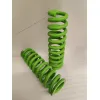Why does a spring lose its energy when compressed for a long time?
A spring loses its energy when compressed for a long time due to a phenomenon known as "creep." Creep is the slow deformation that occurs in a material over an extended period under a constant load or stress. In the case of a compressed spring, the internal structure of the spring material undergoes gradual changes, leading to a reduction in the spring's ability to store and release energy.
Here's a breakdown of the factors contributing to the loss of energy in a spring over time:
Material Deformation:
When a spring is compressed, the material experiences stress and undergoes deformation. Over time, the atomic and molecular structure of the spring material can rearrange or shift, causing a permanent change in its shape.
Plastic Deformation:
Prolonged compression may lead to plastic deformation, where the material does not return to its original shape after the load is removed. Instead, it retains some degree of deformation, resulting in a reduction of the spring's elastic properties.
Internal Friction:
Creep can cause changes in the internal friction of the spring material. As the atomic structure undergoes rearrangement, internal friction increases, leading to energy dissipation in the form of heat.

Material Relaxation:
Over time, the internal stresses within the compression spring material may relax, causing a reduction in the force required to maintain the compressed state. This relaxation contributes to a decrease in the spring's stored potential energy.
Recommended article:Is High Precision Machining the Future of Manufacturing?
Everything You Need to Know About Disc Springs Washers: FAQs Answered
Tips for Choosing the Best Longhe Attachment Contractor
materials api5ct k55
How Does efficient forklift repair services Work?
Essential Tips for Rolling Mill Reducer Maintenance
Are Big Bag Lifter Coupon Services Worth It?
Temperature Effects:
Temperature can influence the rate of creep. Higher temperatures generally accelerate the process of creep, leading to faster deformation and a more rapid loss of energy in the compressed spring.
Load Magnitude:
The magnitude of the applied load also plays a role. Higher loads can accelerate the creep process, causing more pronounced changes in the spring material over time.
Spring Design and Material Choice:
The specific design and material composition of the spring can impact its susceptibility to creep. Some materials exhibit more resistance to creep than others, and certain spring designs may mitigate the effects of prolonged compression.
It's important to note that not all springs experience the same degree of creep, and the rate of energy loss can vary based on factors such as material properties, load conditions, and environmental factors. Manufacturers often consider creep resistance when designing springs for specific applications, choosing materials and configurations that minimize the long-term effects of deformation.
In practical terms, understanding the potential for creep is essential in applications where maintaining consistent spring performance over an extended period is critical. Regular inspection and replacement of vehicle springs that are subject to prolonged compression help ensure the continued reliability and functionality of the spring in various mechanical systems.
Essential Gears for Efficient Petroleum Drilling Machinery
Maximize Warehouse Efficiency with Side Shifter Attachment
How to Choose Longhe Attachments OEM Tips
How do bell washers eliminate residue buildup?
Which longhe attachment solutions are worth investing in?
Revolutionary Technology of Belleville Disc: Game-Changer or Gimmick?
From Mining to Market: The Ultimate Guide to Upgrading ...








Comments
0